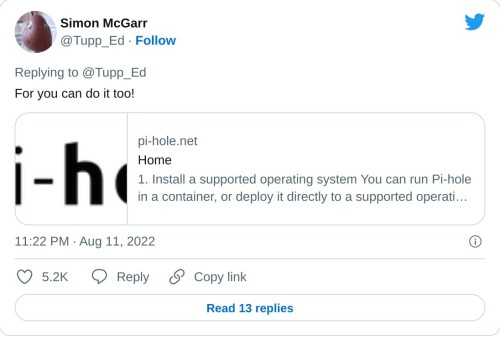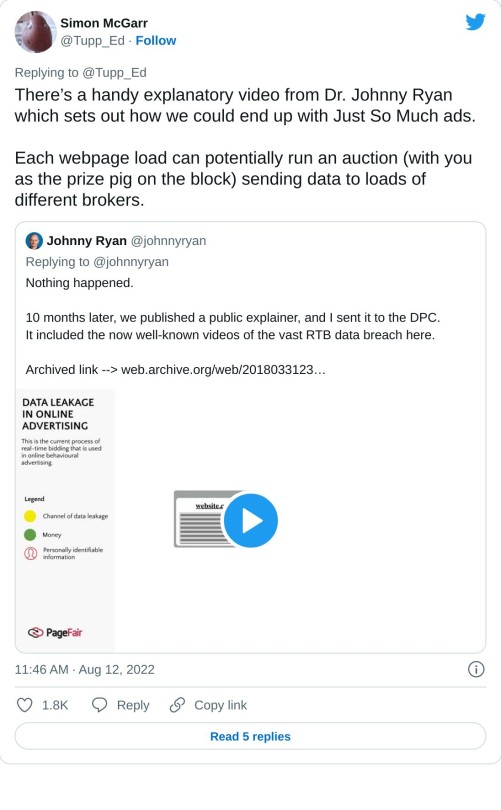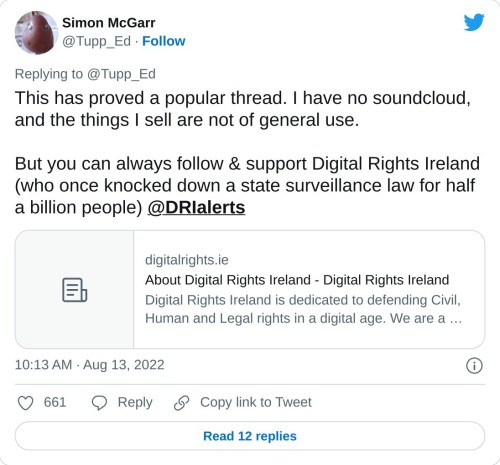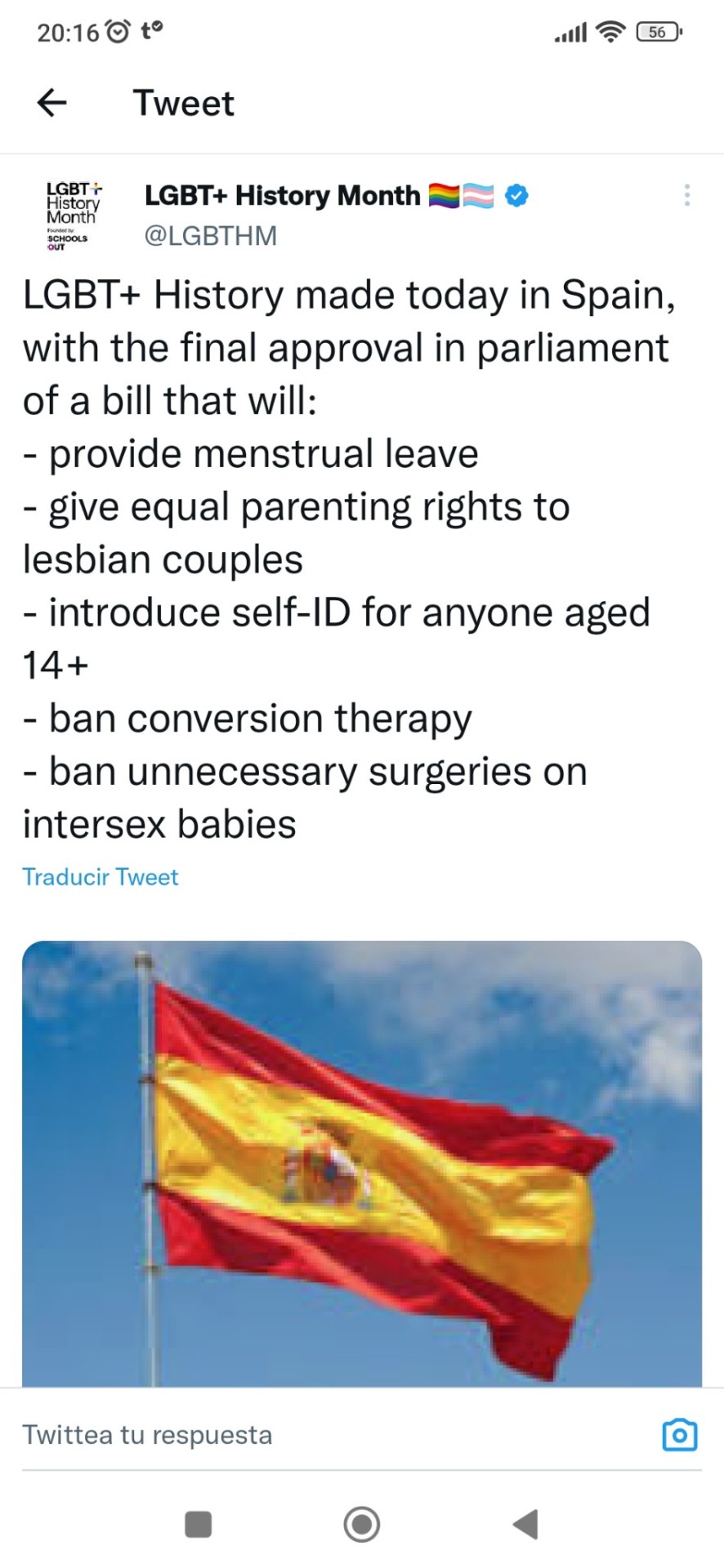>First, We’ve Discovered That About A Quarter Of All The Internet Connection In Or Out Of The House

>First, we’ve discovered that about a quarter of all the internet connection in or out of the house were ad related. In a few hours, that’s about 10,000 out of 40,000 processed.
>We also discovered that every link on Twitter was blocked. This was solved by whitelisting the https://t.co domain.
>Once out browsing the Web, everything is loading pretty much instantly. It turns out most of that Page Loading malarkey we’ve been accustomed to is related to sites running auctions to sell Ad space to show you before the page loads. All gone now.
>We then found that the Samsung TV (which I really like) is very fond of yapping all about itself to Samsung HQ. All stopped now. No sign of any breakages in its function, so I’m happy enough with that.
>The primary source of distress came from the habitual Lemmings player in the house, who found they could no longer watch ads to build up their in-app gold. A workaround is being considered for this.
>The next ambition is to advance the Ad blocking so that it seamlessly removed YouTube Ads. This is the subject of ongoing research, and tinkering continues. All in all, a very successful experiment.
>Certainly this exceeds my equivalent childhood project of disassembling and assembling our rotary dial telephone. A project whose only utility was finding out how to make the phone ring when nobody was calling.

>Update: All4 on the telly appears not to have any ads any more. Goodbye Arnold Clarke!

>Lemmings problem now solved.
>Can confirm, after small tests, that RTÉ Player ads are now gone and the player on the phone is now just delivering swift, ad free streams at first click.
>Some queries along the lines of “Are you not stealing the internet?” Firstly, this is my network, so I may set it up as I please (or, you know, my son can do it and I can give him a stupid thumbs up in response). But there is a wider question, based on the ads=internet model.
>I’m afraid I passed the You Wouldn’t Download A Car point back when I first installed ad-blocking plug-ins on a browser. But consider my chatty TV. Individual consumer choice is not the method of addressing pervasive commercial surveillance.
>Should I feel morally obliged not to mute the TV when the ads come on? No, this is a standing tension- a clash of interests. But I think my interest in my family not being under intrusive or covert surveillance at home is superior to the ad company’s wish to profile them.


>Aside: 24 hours of Pi Hole stats suggests that Samsung TVs are very chatty. 14,170 chats a day.
>YouTube blocking seems difficult, as the ads usually come from the same domain as the videos. Haven’t tried it, but all of the content can also be delivered from a no-cookies version of the YouTube domain, which doesn’t have the ads. I have asked my son to poke at that idea.

More Posts from Postrigbite and Others

Plants do not suffer in silence. Instead, when thirsty or stressed, plants make “airborne sounds,” according to a study published today in Cell1.
Plants that need water or have recently had their stems cut produce up to roughly 35 sounds per hour, the authors found. But well-hydrated and uncut plants are much quieter, making only about one sound per hour.
The reason you have probably never heard a thirsty plant make noise is that the sounds are ultrasonic — about 20–100 kilohertz. That means they are so high-pitched that very few humans could hear them. Some animals, however, probably can. Bats, mice and moths could potentially live in a world filled with the sounds of plants, and previous work by the same team has found that plants respond to sounds made by animals, too.
Crying crops To eavesdrop on plants, Lilach Hadany at Tel-Aviv University in Israel and her colleagues placed tobacco (Nicotiana tabacum) and tomato (Solanum lycopersicum) plants in small boxes kitted out with microphones. The microphones picked up any noises made by the plants, even if the researchers couldn't hear them. The noises were particularly obvious for plants that were stressed by a lack of water or recent cutting. If the sounds are pitched down and sped up, “it is a bit like popcorn — very short clicks”, Hadany says. “It is not singing.”
Plants do not have vocal cords or lungs. Hadany says the current theory for how plants make noises centers on their xylem, the tubes that transport water and nutrients from their roots to their stems and leaves. Water in the the xylem is held together by surface tension, just like water sucked through a drinking straw. When an air bubble forms or breaks in the xylem, it might make a little popping noise; bubble formation is more likely during drought stress. But the exact mechanism requires further study, Hadany says.
The team produced a machine-learning model to deduce whether a plant had been cut or was water stressed from the sounds it made, with about 70% accuracy. This result suggests a possible role for the audio monitoring of plants in farming and horticulture.
To test the practicality of this approach, the team tried recording plants in a greenhouse. With the aid of a computer program trained to filter out background noise from wind and air-conditioning units, the plants could still be heard. Pilot studies by the authors suggest that tomato and tobacco plants are not outliers. Wheat (Triticum aestivum), corn (Zea mays) and wine grapes (Vitis vinifera) also make noises when they are thirsty.
Chattering grasses? Previously, Hadany’s team has also studied whether plants can ‘hear’ sounds, and found that beach evening-primoses (Oenothera drummondii) release sweeter nectar when exposed to the sound of a flying bee2.
So are plant noises an important feature of ecosystems, influencing the behaviour of plants and animals alike? The evidence isn’t yet clear, according to Graham Pyke, a retired biologist at Macquarie University in Sydney, Australia, who specializes in environmental science.
He’s sceptical that animals listen to the moans of stressed plants. “It is unlikely that these animals are really able to hear the sound at such distances,” he says. He thinks the sounds would be too faint. Further research should shed more light on the matter. But Pyke says he’s perfectly willing to accept that plants ‘squeal’ when stressed.
People protect a woman who is burning her scarf
the total number of detainees during the nationwide uprising in Iran is estimated at 6,000.
in this post I will talk about some of them.

(tw:beating) this is Armita Abbasi. she is 20 years old, she was last seen in a hospital after her arrest because she was reportedly beaten with a baton. her whereabouts are unknown.

this is Saeed Heleichi, an Arab poet and activist. he was arrested on October 19.

this is Soheil Khoshdel, a 17 yo protester who was arrested and sent to a correctional center just because of protesting.

this is Samane Asqari, a children rights activist. the police officers introduced themselves as employees of water department so they can enter her house and arrest her.

this is Badi' Khaze'i. he was arrested alongside his friends. after realizing that he's a follower of Baha'i religion, the police transferred him to Evin prison of Tehran which is 792 miles away from his hometown.

Elnaz Rekabi, a climber who refused to wear the hijab in a competition is reportedly under house arrest.

(tw: beating and torture) this is the moment of Hossein Ronaghi's arrest. he has been arrested several times over the past 20 years. this time he was arrested for being interviewed by an anti-regime broadcasting station. he was violently taken away by the police in front of a courthouse. he was going to turn himself in but he was still beaten by the police. both of his legs are broken and he has been tortured for days without any treatment. he's also on a hunger strike.

this is Atrin Azarfar. she's a Kurdish graphic designer who was arrested on October 19. her whereabouts are unknown.

this is Fatemeh Sepehri, a political and women's rights activist. she was arrested because of her interview with an anti-regime tv station. she has been kept in a solitary confinement since September 21.

this is Niloofar Hamedi, a journalist who reported Jina Amini's murder and shared a photo of her parents. she's been arrested for doing her job.
say their names, talk about them.

Me and the mutuals reblogging the same 5 posts back and forth
Weird peeve time. Calling lab grown gemstones "fake" is stupid because it's the same shit just not formed naturally. An artificially grown diamond is the same shit as a natural diamond it is the exact same material bro it's all fuckign carbon


Skip Google for Research
As Google has worked to overtake the internet, its search algorithm has not just gotten worse. It has been designed to prioritize advertisers and popular pages often times excluding pages and content that better matches your search terms
As a writer in need of information for my stories, I find this unacceptable. As a proponent of availability of information so the populace can actually educate itself, it is unforgivable.
Below is a concise list of useful research sites compiled by Edward Clark over on Facebook. I was familiar with some, but not all of these.
⁂
Google is so powerful that it “hides” other search systems from us. We just don’t know the existence of most of them. Meanwhile, there are still a huge number of excellent searchers in the world who specialize in books, science, other smart information. Keep a list of sites you never heard of.
www.refseek.com - Academic Resource Search. More than a billion sources: encyclopedia, monographies, magazines.
www.worldcat.org - a search for the contents of 20 thousand worldwide libraries. Find out where lies the nearest rare book you need.
https://link.springer.com - access to more than 10 million scientific documents: books, articles, research protocols.
www.bioline.org.br is a library of scientific bioscience journals published in developing countries.
http://repec.org - volunteers from 102 countries have collected almost 4 million publications on economics and related science.
www.science.gov is an American state search engine on 2200+ scientific sites. More than 200 million articles are indexed.
www.pdfdrive.com is the largest website for free download of books in PDF format. Claiming over 225 million names.
www.base-search.net is one of the most powerful researches on academic studies texts. More than 100 million scientific documents, 70% of them are free


some good news!! the spanish state's ministry of equality has finally passed one of the most progressive trans laws on the planet, shielded free and universal access to abortion and banned conversion therapy and genital surgery for intersex babies, among a lot of other feminist policies. the minister of equality irene montero gave a speech thanking spain's lgtb and trans associations for helping her draft these legislations. couldn't be more proud!!

hope this explains it
-
 generatedusername reblogged this · 2 months ago
generatedusername reblogged this · 2 months ago -
 generatedusername liked this · 2 months ago
generatedusername liked this · 2 months ago -
 prometheuslovechild liked this · 2 months ago
prometheuslovechild liked this · 2 months ago -
 fluid-as-fuck-pansexual reblogged this · 2 months ago
fluid-as-fuck-pansexual reblogged this · 2 months ago -
 fluid-as-fuck-pansexual liked this · 2 months ago
fluid-as-fuck-pansexual liked this · 2 months ago -
 chasingyestergay liked this · 2 months ago
chasingyestergay liked this · 2 months ago -
 reindeerking liked this · 2 months ago
reindeerking liked this · 2 months ago -
 catchychaos liked this · 2 months ago
catchychaos liked this · 2 months ago -
 planty-pup reblogged this · 2 months ago
planty-pup reblogged this · 2 months ago -
 planty-pup liked this · 2 months ago
planty-pup liked this · 2 months ago -
 thepiromancer liked this · 2 months ago
thepiromancer liked this · 2 months ago -
 crumb-dumpster-3000 liked this · 2 months ago
crumb-dumpster-3000 liked this · 2 months ago -
 adventures-of-light liked this · 2 months ago
adventures-of-light liked this · 2 months ago -
 tritzie liked this · 2 months ago
tritzie liked this · 2 months ago -
 fag-gay-le reblogged this · 2 months ago
fag-gay-le reblogged this · 2 months ago -
 dropdeadgarbage reblogged this · 2 months ago
dropdeadgarbage reblogged this · 2 months ago -
 powerofthequill reblogged this · 2 months ago
powerofthequill reblogged this · 2 months ago -
 oopsiedazeyy reblogged this · 2 months ago
oopsiedazeyy reblogged this · 2 months ago -
 frreakoutt liked this · 2 months ago
frreakoutt liked this · 2 months ago -
 croapunk reblogged this · 2 months ago
croapunk reblogged this · 2 months ago -
 gotmauld liked this · 2 months ago
gotmauld liked this · 2 months ago -
 hereforcookies liked this · 2 months ago
hereforcookies liked this · 2 months ago -
 hereforcookies reblogged this · 2 months ago
hereforcookies reblogged this · 2 months ago -
 bihockeyguy42 liked this · 2 months ago
bihockeyguy42 liked this · 2 months ago -
 dr-zl reblogged this · 2 months ago
dr-zl reblogged this · 2 months ago -
 tomontheinterwebs reblogged this · 2 months ago
tomontheinterwebs reblogged this · 2 months ago -
 kittyboyswag liked this · 2 months ago
kittyboyswag liked this · 2 months ago -
 towalkinyourlight liked this · 2 months ago
towalkinyourlight liked this · 2 months ago -
 6o09 reblogged this · 2 months ago
6o09 reblogged this · 2 months ago -
 splo0ldz reblogged this · 2 months ago
splo0ldz reblogged this · 2 months ago -
 splo0ldz liked this · 2 months ago
splo0ldz liked this · 2 months ago -
 neoncactushalo liked this · 2 months ago
neoncactushalo liked this · 2 months ago -
 imwayfindin reblogged this · 2 months ago
imwayfindin reblogged this · 2 months ago -
 imwayfindin liked this · 2 months ago
imwayfindin liked this · 2 months ago -
 vanity-complex liked this · 2 months ago
vanity-complex liked this · 2 months ago -
 nicky999doors liked this · 2 months ago
nicky999doors liked this · 2 months ago -
 garchomp-ings reblogged this · 2 months ago
garchomp-ings reblogged this · 2 months ago -
 girlboss-malewife reblogged this · 2 months ago
girlboss-malewife reblogged this · 2 months ago -
 girlboss-malewife liked this · 2 months ago
girlboss-malewife liked this · 2 months ago -
 heshefey reblogged this · 2 months ago
heshefey reblogged this · 2 months ago -
 heshefey liked this · 2 months ago
heshefey liked this · 2 months ago -
 actiasluna reblogged this · 2 months ago
actiasluna reblogged this · 2 months ago -
 actiasluna liked this · 2 months ago
actiasluna liked this · 2 months ago -
 aphroditesfever reblogged this · 2 months ago
aphroditesfever reblogged this · 2 months ago -
 halima42 liked this · 2 months ago
halima42 liked this · 2 months ago -
 aphroditesfever liked this · 2 months ago
aphroditesfever liked this · 2 months ago -
 mercaritrickster reblogged this · 2 months ago
mercaritrickster reblogged this · 2 months ago
